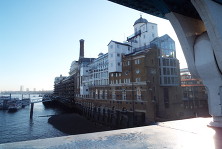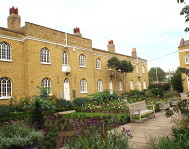








The Old Burial Ground, Dulwich
The Old Burial Ground in Dulwich Village is closed to the public but the recent cutting down of trees and shrubs around the perimeter means that passers-by are now able to have a good view inside. It contains many Grade II listed tomb chests that predominantly date from the late 18th century and early 19th century. The decorative wrought iron entrance gates dated 1728 together with the railings and boundary walls are also Grade II listed
It was consecrated on the same day as Christ’s Chapel of God’s Gift, 1 September 1616,* Edward Alleyn’s 50th birthday. The ceremony was performed by George Abbott, the Archbishop of Canterbury. In his request that the church and burial ground be consecrated, Alleyn stated that St Giles in Camberwell, the nearest church, was two miles away and he and his family found it difficult, especially in winter and when it rained, to travel to St Giles in good time to attend divine service. There was also a plot of land which he wanted to set aside as a burial place for those who died within the hamlet of Dulwich.
From the time the burial ground was consecrated, many thousands were buried there until it was closed for further burials in 1856 as, despite being twice enlarged, the graveyard was full. 35 residents of Dulwich who were victims of the Great Plague were buried there in 1665, Old Bridget, Queen of the Gipsies was buried there in 1768, and murder victim Samuel Matthews, the ‘Hermit of Dulwich’ who lived in a cave in Dulwich Woods, was buried there in 1802.
*Plans are in hand for the celebrating the 400th anniversary of the consecration.
The largest tomb is that of Richard Shawe, a solicitor who defended Warren Hastings at his trial for corruption. He spent his enormous fee on building a mansion called Casina House (later Casino House) on Denmark Hill. He died in 1816 but his mansion survived until 1906 when it was demolished. The Sunray Estate was built in its grounds.
Despite the prohibition of further burials after 1856, there were exceptions. Thomas Goodman, landlord at the Crown Inn (forerunner to the Crown and Greyhound), was buried there in 1860 and his wife Mary in 1877. It appears that they had already acquired a family vault in the cemetery in 1829 and had, as it were, reserved their places. See photograph of plaque to the left - click to enlarge.
Mrs Basil Holmes in her survey of London Burial Grounds of 1897 described the cemetery as “very neatly kept. There are several large altar tombs in it, and it is a most rural and picturesque spot.” Restoration work to some of the tombs which included repointing and repair of stonework was carried out in 2006.
Web discoveries
- UK Casino Not On Gamstop
- UK Casino Not On Gamstop
- Non Gamstop Casino
- Casinos Not On Gamstop
- Non Gamstop Casinos
- Non Gamstop Casinos
- Non Gamstop Casino
- Casino Sites Not On Gamstop
- Slots Not On Gamstop
- Casinos Not On Gamstop
- UK Betting Sites Not On Gamstop
- UK Casino Not On Gamstop
- Best Non Gamstop Casinos
- Betting Sites
- Non Gamstop Casino Sites UK
- Best Non Gamstop Casinos
- Non Gamstop Casino
- Casinos Not On Gamstop
- Non Gamstop Casino Sites UK